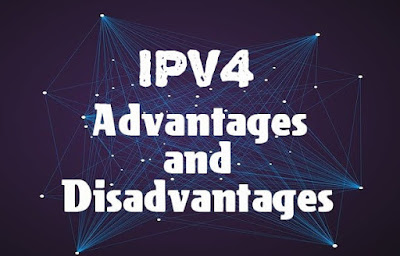What is IPv4 ?
Since IPv4 failed to anticipate the growth of the internet, IPv6 came as a successor to them. Al though IPv6 was introduced as an advancement module to Internet Protocol, there are still many users who consider the old IPv4 model. Thus, migrating to IPv6 cannot be always guaranteed as a good idea. Before embarking IPv4 protocol module it is important to understand its pros and cons.
In this article, I will be illustrating 6 Advantages and Disadvantages of IPv4 | Drawbacks & Benefits of IPv4 . Through this post, you will know the pros and cons of using IPv4 module.
Let's get started,
Advantages of IPv4
1. Encryption
Whenever communications are used in public medium, it is necessary to encrypt data to ensure privacy. IPv4 takes security measures to encrypt data in its address packets. Hence, privacy as well as security is maintained to a higher extent in IPv4.
2. Flexibility
Since address are combined more effectively, the process of routing has become more efficient in IPv4. Therefore, organizations that regularly use multicast, their data communication has been more specific.
3. Topology Support
Unlike IPv6 protocol where it is been complicated to be implemented in most topology drawings, a IPv4 protocol can be easily supported by most of the topology drawings. This is because it contains simple prefixes which can be easily fit inside them.
4. System Support
The IPv4 routing present inside the IPv4 protocol can be handled easily by all the systems. As a result the IPv4 protocol can be supported by most major systems out there.
5. Device Connectivity
The primary function of IPv4 is to connect different types of devices all across the large network. Along with the connection, identity verification can be done for each device. And also all those can be done without the usage of NAT.
6. Data Delivery
IPv4 takes great measures to deliver data packets right to its host. This is because the versions of IPv4 gets hired by the Transmission Control Protocol (TCP). Hence, data can be guaranteed of delivery and avoidance of duplicate.
Disadvantages of IPv4
1. Configurations
IPv4 needs configuration either manually or automatically. Configuring IPv4 manually has to be done through Dynamic Host Configuration Protocol (DHCP). Configurations of DHCP is complex since separate management needs to be done for its infrastructure.
2. Security
Since IPv4 was published long time back, it was not meant to secure from threats imposed today. Therefore, Internet Protocol Security (IPSec) enables network security to IPv4 by specifying the use of the internet. But the problem lies when IPSec is not built in and its implementation is optional.
3. Infrastructure
In IPv4 individual address prefixes are assigned so that each of them can become new router. Moreover internet today contains flat and hierarchical routers. However there are more than 85000 routes in the internet backbone routers.
4. Mobility
Even though IPv4 contains a specification for its mobility, it is considered to be inefficient. The reason for this is the fact that it has its own infrastructure. Hence, its mobility nodes are inefficient too.
5. Access Space
Depletion of Public address is another problem faced while using IPv4. This is mainly due to the initial address class allocation practices. For counteracting this address space scarcity, the process of Network Address Translation (NAT) is introduced. In NAT one single public IPv4 address is shared among various privately addressed computers.
6. Geographical Restrictions
The country that is known for creating the internet is the US. Therefore, this country is involved in the process of IP address distribution too. In fact most of the address are reserved in the US.










No comments:
Post a Comment